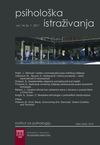Povezanost igranja nasilnih video-igrica i vršnjačkog nasilja kod adolescenata u Srbiji
The Correlation between Playing Violent Video Games and Bullying among Adolescents in Serbia
Author(s): Ana Jevtić, Milomirka SavićSubject(s): Psychology, Social psychology and group interaction
Published by: Филозофски факултет, Универзитет у Београду
Keywords: bullying; aggressive behaviour; video games; content violence; parental control;
Summary/Abstract: The aim of this study was to determine the frequency of playing video games among Serbian adolescents, the video game violence and the quality of parental control. We wanted to relate the frequency of playing, the video game violence, the bullying behaviour in schools, and GPA. The study involved boys and girls (N = 578) from four age groups (12, 14, 16, 18 years). Research results have shown that most participants play video games (75.1%). There are significantly more boys than girls among them, as well as more older than younger participants. Parental control is weak; a very small percentage of the sample (4.4%) reported that their parents had forbidden them to play a game because of its content. The parents mostly never check which games their children play (50.2 %), and the majority (40.6 %) do not even talk with the children about the games they play. GPA is negatively correlated with the frequency of playing (r = –0.228, p<.01) and the frequency remains a significant predictor of GPA even when controlling for age and gender. Those who play more violent games display more bullying behaviour (r=0.403, p<.01) This effect remains significant even when controlling for gender, age, the amount of TV violence and frequency of watching TV. The amount of violence in video games as a predictor has a unique contribution to the explanation of individual differences in bullying; the factor has a small but significant contribution to the explanation of this form of aggressive behaviour.
Journal: Psihološka istraživanja
- Issue Year: 16/2013
- Issue No: 2
- Page Range: 191-208
- Page Count: 18
- Language: Serbian

